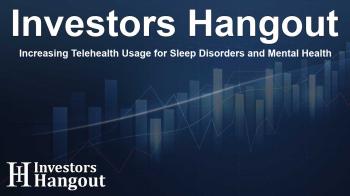Increasing Telehealth Usage for Sleep Disorders and Mental Health

Telehealth Diagnostic Categories Show Remarkable Trends
As the landscape of healthcare continues to evolve, recent data has highlighted the significant role of telehealth in diagnosing various conditions. Sleep disorders have emerged as one of the top five telehealth diagnostic categories reported nationwide, according to the latest statistics from FAIR Health's Monthly Telehealth Regional Tracker.
Sleep Disorders Entering the Top Five
In March, sleep disorders seized the fifth position among the national telehealth diagnostic categories, representing 1.8 percent of telehealth claims. This notable shift displaced overweight and obesity, which had been prevalent in this category just the month prior. Interestingly, the West region witnessed similar trends, with sleep disorders making an entry into the top five at the same ranking, reflecting changing patient needs and preferences in remote healthcare services.
Mental Health Remains Dominant
Mental health conditions have retained their standing as the leading diagnostic category across all regions, accounting for a substantial 61.6 percent of telehealth claims nationally. While there was a slight decrease from the previous month, the numbers indicate a strong and consistent demand for mental health services via telehealth platforms. Regionally, these figures fluctuated, with the Northeast showing the highest percentage at 68.2 percent and the South at 55.9 percent, underscoring regional variations in healthcare utilization.
Trends in Telehealth Utilization
The percentage of patients utilizing telehealth claims has seen a slight decline nationally, moving from 14.5 percent in February down to 14.3 percent in March. This drop was mirrored in all regions, with the exception of the West, where claims rose by 1.8 percent. Such trends reflect both the shifting behavioral patterns of patients and the evolving dynamics of healthcare accessibility.
Urban Versus Rural Digital Care Services
A distinct divide still exists between urban and rural telehealth utilization. Data indicates that urban patients are utilizing telehealth services at a significantly higher rate of 14.5 percent compared to their rural counterparts at just 7.2 percent. This discrepancy highlights existing barriers to access for rural healthcare consumers, which can impact overall healthcare outcomes and service delivery.
Age Demographics in Telehealth Claims
Age factors significantly into telehealth usage trends as well. Patients aged 19-30 and those aged 31-40 represented the largest shares of telehealth claims, with 23.3 percent and 22.6 percent, respectively. In contrast, children and seniors exhibited much lower engagement, both below 10 percent. This suggests younger demographics may be more inclined to access healthcare services digitally.
Procedure Categories Utilized in Telehealth
March data also emphasizes the prevalence of certain procedure categories linked with telehealth. Both established patient office or outpatient services and psychotherapy services topped the list nationally. While these categories hold strong positions, there are regional variances, reflecting how distinct areas approach telehealth consultation.
Understanding the Monthly Telehealth Regional Tracker
The Monthly Telehealth Regional Tracker, initiated to provide insights into evolving telehealth trends, leverages FAIR Health's extensive data to illustrate monthly shifts in healthcare utilization. It presents a clear visual representation of trends regarding telehealth claims—further contributing to the understanding of patient behaviors and needs across regions.
About FAIR Health
FAIR Health is recognized for its commitment to improving transparency in healthcare costs and insurance data. As a leading nonprofit organization, it serves as a resource for consumers and healthcare professionals alike, facilitating access to critical information and insights into healthcare expenditures. Its comprehensive database encompasses over 51 billion healthcare claims, continuing to expand annually. The organization’s efforts underscore the importance of reliable healthcare data and its impact on various stakeholders within the healthcare ecosystem.
Frequently Asked Questions
What are the top telehealth diagnostic categories?
Sleep disorders and mental health conditions are currently among the top telehealth diagnostic categories, reflecting patients' ongoing healthcare needs.
How has telehealth utilization changed?
Telehealth utilization has experienced some fluctuation, with a slight national decline but increases in certain regions like the West.
Who uses telehealth services more?
Urban patients tend to utilize telehealth services significantly more than rural patients, highlighting disparities in access to care.
Which age groups are most engaged with telehealth?
Patients between the ages of 19-40 are the most engaged demographics using telehealth services.
What is the purpose of the Monthly Telehealth Regional Tracker?
The Monthly Telehealth Regional Tracker aims to provide insights on how telehealth utilization evolves over time, showcasing various data points and trends.
About The Author
Contact Dominic Sanders privately here. Or send an email with ATTN: Dominic Sanders as the subject to contact@investorshangout.com.
About Investors Hangout
Investors Hangout is a leading online stock forum for financial discussion and learning, offering a wide range of free tools and resources. It draws in traders of all levels, who exchange market knowledge, investigate trading tactics, and keep an eye on industry developments in real time. Featuring financial articles, stock message boards, quotes, charts, company profiles, and live news updates. Through cooperative learning and a wealth of informational resources, it helps users from novices creating their first portfolios to experts honing their techniques. Join Investors Hangout today: https://investorshangout.com/
The content of this article is based on factual, publicly available information and does not represent legal, financial, or investment advice. Investors Hangout does not offer financial advice, and the author is not a licensed financial advisor. Consult a qualified advisor before making any financial or investment decisions based on this article. This article should not be considered advice to purchase, sell, or hold any securities or other investments. If any of the material provided here is inaccurate, please contact us for corrections.

